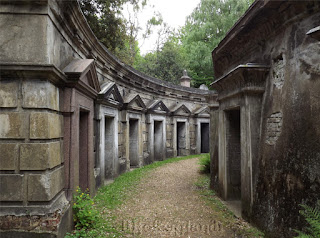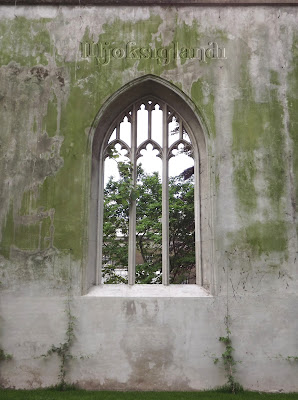When buying my ticket I used a machine, which gave me the option of selecting one for a high-speed train. As this cost a few pounds more, I did not go with that option. Then, ticket in hand, I looked at the trains in front of me, all of which had the words 'high-speed' emblazoned on them. So over I went to the railroad employees, who I hope were getting time and a half for working on the holiday and who were all just as pleasant as they could be, and asked if I'd need the high-speed ticket. I would, but it was no problem to simply pay for the surcharge without buying entirely new tickets.
The trip was uneventful as the train made its way eastward and somewhat north. I kept thinking of the most recent Robin Hood film, because one of the train's stops was in Gravesend, and in the film the returning Crusaders pass through that area on their way back from France. As I was preparing to alight at Rochester, the punk who'd been sitting in the same carriage woke up and asked, very politely, if we'd already passed one of the previous stations. I felt bad that he'd missed his stop, but was pleased by his good manners, and by being proved wrong in my assumptions based on his style.
As the train approached Rochester I could see the tower of the castle, and grew dismayed as we kept
going. Though the station did not appear as near as I'd hoped to the attractions I was visiting, they turned out to be not very far away at all, and easy to find. I walked up a small hill and found myself on a bunting-canopied historic, and rather empty, street. At first I was worried that everything was going to be shut up because it was a bank holiday, but then I considered that it was not yet 10 a.m., and that things would probably open later. As it was, the only people I saw as I strolled were a group of voluble French students.
I soon gleaned that the bunting was decoration for the Dickens Festival, which would be happening at the following weekend. Rochester was a favourite of Dickens, and he patterned many locations in his works after real buildings in the town; these are marked with plaques noting in which novels they appear and what they are called there. There are also lots of shops whose names contain Dickensian references, like Pip's greengrocers and Sweet Expectations.
I was about halfway up the street when suddenly to my left there was an open area, rather than the row of shops that preceded and followed it, and the cathedral appeared. A set of steps led up from street level into a little grassy courtyard with benches and a fountain in the middle; beyond that was a wrought-iron gate into the cathedral grounds, leading to the main entrance. Directly opposite the west doors of the cathedral is the castle. I don't believe two places I've been to visit have ever been so conveniently located before.
 Founded in the 7th century, Rochester is the second-oldest cathedral in England, though the present building only dates from the 11th century. If I remember correctly, it is also the shortest in length of all England's medieval cathedrals. One of the things I liked best about it was the bathroom, because it was hidden behind a little door in a very medieval-looking corridor. It was also impressive how modern and comfortable the bathroom was, given its location; it must have taken some work to plumb everything in. Like St Albans, Rochester was also a pilgrimage site, and includes a set of steps that were used by penitent visitors as they made their way to the shrine behind the altar. The stone steps have become so worn down and concave over the years that wooden steps have been built over them to make the ascent easier (and likely safer). The cathedral's quire screen was especially nice, carved with saints and patrons of the church, but I also enjoyed seeing memorials to military service, including a regiment in Gibraltar, and the poppies arranged by the Great War memorial.
Founded in the 7th century, Rochester is the second-oldest cathedral in England, though the present building only dates from the 11th century. If I remember correctly, it is also the shortest in length of all England's medieval cathedrals. One of the things I liked best about it was the bathroom, because it was hidden behind a little door in a very medieval-looking corridor. It was also impressive how modern and comfortable the bathroom was, given its location; it must have taken some work to plumb everything in. Like St Albans, Rochester was also a pilgrimage site, and includes a set of steps that were used by penitent visitors as they made their way to the shrine behind the altar. The stone steps have become so worn down and concave over the years that wooden steps have been built over them to make the ascent easier (and likely safer). The cathedral's quire screen was especially nice, carved with saints and patrons of the church, but I also enjoyed seeing memorials to military service, including a regiment in Gibraltar, and the poppies arranged by the Great War memorial. On the side closest to the cathedral is the castle's former moat, now grass-filled, which features a small plaque noting Dickens' desire to be buried there (they stuck him in Poets' Corner in Westminster Abbey instead). Beyond the moat is a wall enclosing the castle grounds, and within is a large grassy area with a few trees. As this part is free to enter, it seemed as popular with the locals as with tourists; in the afternoon there were people picnicking and playing cricket there, and a group of teenagers had climbed onto the roof of the building that housed the toilets and were getting a talking-to from an employee as I used the facilities. The 'castle' is really just the keep, a large rectangle rising up at one end of the grounds, and it is there that you must pay if you want to see any of what's inside.
On the side closest to the cathedral is the castle's former moat, now grass-filled, which features a small plaque noting Dickens' desire to be buried there (they stuck him in Poets' Corner in Westminster Abbey instead). Beyond the moat is a wall enclosing the castle grounds, and within is a large grassy area with a few trees. As this part is free to enter, it seemed as popular with the locals as with tourists; in the afternoon there were people picnicking and playing cricket there, and a group of teenagers had climbed onto the roof of the building that housed the toilets and were getting a talking-to from an employee as I used the facilities. The 'castle' is really just the keep, a large rectangle rising up at one end of the grounds, and it is there that you must pay if you want to see any of what's inside.I have told several people this story before, and by George I will tell it again because it may be one of my favourite things that I have ever read about a castle. When I was deciding where to go on the bank holiday Monday, I read a bit about Rochester and saw that it was fairly easily reached from London. Knowing that I delved deeper, and came across the TripAdvisor page for the castle. TripAdvisor lets users rate and review attractions, and among the many four- and five-star ratings I saw that the castle had three one-star, or Terrible, ratings. I had to check these out; I can't think of a castle I've been to that I would rate so poorly, but perhaps these reviewers had experiences that I ought to know about before I decided to visit.
The first of the Terrible reviews was about the Christmas market, so I felt safe ignoring that one. The next two left me flabbergasted. Both were from Brits, and both said that they'd visited with people who had some kind of handicap. And both reviewers were upset that there was no lift in the castle. (That's an elevator, for all of our Spanish-speaking friends.) Yes: not one but two people expected that the castle that was begun in the 12th century would have a lift inside. I must admit that I was pleased to see that these reviewers were from the UK and not the States.

As it is just a tower, there's not a lot to see inside. One room near the bottom has a display showing a diorama of the castle at its most complete, and includes a timeline of its history, but as the majority of the building is devoid of a roof or floors that aren't in the corridors, there is no furniture or decoration. There are informational panels describing, in English and French, what the various rooms would have been, with illustrations showing them filled with people at work. All the same, it didn't seem like it would have been a comfortable place to live; the squareness of it must have been somewhat monotonous for its inhabitants. I was very slightly unsettled by Rochester Castle--not actively uncomfortable, but vaguely aware that something seemed off. Eventually I realised that it was mainly because of the arches. With possibly one or two exceptions, most of the arches are Norman (or Romanesque, if you're on the Continent). This means that they are the rounded kind, rather than pointed Gothic ones. For someone used to seeing mainly Gothic arches, their marked absence in Rochester was odd.
Before I left I decided that I ought to get fish and chips. There was a chipper on the street near the cathedral entrance, and from there I ordered cod and chips. What I got was the biggest piece of fish I've ever eaten. It was easily nine inches long. Of course it was good, crisp and hot and filling, and I ate it sitting on a bench near the cathedral. Would that there were more meals in such locations in my life.
On the way back to London someone came round to check our tickets, and I presented both my original Rochester-St Pancras ticket and the one for the upgrade. 'And you've got the other bit as well, aren't you very good, my love,' said the conductor checking tickets. Yes, I am, I thought, well pleased with myself and with having been in a cathedral and a castle and having eaten my fill of fish and chips in a pleasant town.


































